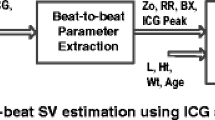Abstract
This study evaluates the use of artificial neural networks to estimate stroke volume from pre-processed, thoracic impedance plethysmograph signals from 20 healthy subjects. Standard back-propagation was used to train the networks, with Doppler stroke volume estimates as the desired output. The trained networks were then compared to two classical biophysical approaches. The coefficient of determination R2 × 100%) between the biophysical approaches and the Doppler was 8.20% and 9.90%, while it was 77.38% between the best neural network and the Doppler. Among these methods, only the neural network residuals had a significant zero mean Gaussian distribution (α =0.05). Our results indicate that an invertible relationship may exist between thoracic bioimpedance and stroke volume, and that artificial neural networks may offer a potentially advantageous approach for estimating stroke volume from thoracic electrical impedance, both because of their ease of use and their lack of confounding assumptions. © 1998 Biomedical Engineering Society.
PAC98: 8780+s, 8437+q, 8435+i, 0630Bp
Similar content being viewed by others
REFERENCES
Berman, I., W. Scheetz, E. Jenkins, and H. Hufnagel. Transthoracic electrical impedance a guide to intravascular overload. Arch. Surg.102:61-64, 1971.
Bernstein, D. P. A new stroke volume equation for thoracic electrical bioimpedance: Theory and rationale. Crit. Care Medicine14:904-909, 1986.
Churchill, S. E. Fundamentals of Space Sciences, Vol. 1. Malabar, FL: Kreiger, 1997.
Donovan, K., G. Dobb, W. Woods, and B. Hockings. Comparison of transthoracic electrical impedance and thermodilution methods for measuring cardiac output. Crit. Care Medicine14:1038-1044, 1986.
Geddes, L. A. The Direct and Indirect Measurement of Blood Pressure. Chicago, IL: Yearbook Medical, 1970.
Handelsman, H. Cardiac output by electrical bioimpedance. Health Technology Assessment Report3:1-5, 1989.
Haykin, S. Neural Networks - A Comprehensive Foundation. New York, NY: Macmillan College, 1994.
Judy, W., F. Langley, K. McCowen, D. Stinnett, L. Baker, and P. Johnson. Comparative evaluation of the thoracic impedance and isotope dilution methods for measuring cardiac output. Aerospace Medicine40:532-536, 1969.
Kubicek, W. On the source of peak first time derivative (dz/dt) during impedance cardiography. Ann. Biomed. Eng.17:459-462, 1989.
Kubicek, W., A. From, R. Patterson, D. Witsoe, A. Castaneda, R. Lillehei, and R. Ersek. Impedance cardiography as a noninvasive means to monitor cardiac function. J. Assoc. Adv. Medical Instrumen.4:79-84, 1970.
Kubicek, W., J. Karnegis, R. Patterson, D. Witsoe, and R. Mattson. Development and evaluation of an impedance cardiac output system. Aerospace Medicine37:1208-1212, 1966.
Kubicek, W., J. Kottke, M. Ramos, R. Patterson, D. Witsoe, J. Labree, W. Remole, T. Layman, H. Schoening, and J. Garamela. The Minnesota impedance cardiograph-theory and applications. Biomed. Eng.9:410-419, 1974.
Kumar, A. A. R., B. C. Taylor, A. P. Mulavara, M. S. Nair, V. B. Gupta, and W. D. Timmons. A Neural network approach to electrical impedance cardiography, In: Proceedings of the 16th Annual International Conference of the IEEE EMBS, Baltimore, Maryland, 1994.
Levett, J., and R. Replogle. Thermodilution cardiac output: a critical analysis and review of the literature. J. Surg. Res.27:392-404, 1979.
Ljung, L. System Identification: Theory for the User. Englewood Cliffs, NJ: Prentice-Hall, 1987.
Luepker, R., J. Michael, and J. Warbasse. Transthoracic electrical impedance; quantitative evaluation of a non-invasive measure of thoracic fluid volume. Am. Heart J.85:83-93, 1973.
Meijer, J., J. Reulen, P. Oe, W. Allon, L. Thijs, and H. Schneider. Differential impedance plethysmography for measuring thoracic impedance's. Med. Biol. Eng. Comp.20:187- 194, 1982.
Miller J., and S. Horvath. Impedance cardiography. Psychophysiology15:80-91, 1978.
Nyober, J. Electrical Impedance Plethysmography. Spring-field, IL: Thomas C.C., 1969.
Roos, J., H. Koomans, P. Boer, and E. D. Mees. Transthoracic electrical impedance as an index of extracellular fluid volume in man. Intensive Care Medicine11:39-42, 1985.
Sramek, B. Cardiac output by electrical impedance. Med. Electron.1982:93-97 (April).
Taylor, B. C. Evaluation of bioimpedance for the measurement of physiologic variables as related to hemodynamic studies in spaceflight. NASA Johnson Space Center, Houston, NASA/ASEE Summer Faculty Fellowship Program, 1993.
Author information
Authors and Affiliations
Rights and permissions
About this article
Cite this article
Mulavara, A.P., Timmons, W.D., Nair, M.S. et al. Electrical Impedance Cardiography Using Artificial Neural Networks. Annals of Biomedical Engineering 26, 577–583 (1998). https://doi.org/10.1114/1.47
Issue Date:
DOI: https://doi.org/10.1114/1.47




